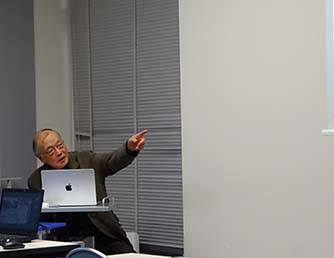

| Date & Time | Tuesday, October 18, 2022, 15:45-17:00 |
| Place | Seminar Rooms B and C, Sousei Bldg. 4F |
| Method | Hybrid | Participant | 16 people (including 11 online) |
| Lecturer: Hiroshi Hayasaka (ARC) Presentation Title: Fire Weather Conditions in the Arctic Region Abstract: Fire activity in 288 areas (2.5◦ N × 10◦ E) in the Arctic region (50◦–70◦ N, 0◦–360◦ E) was analyzed using satellite hotspot data (number of HSs = about 4.4 million) from 2002 to 2021. A total of 21 high fire density areas were selected and their fire–weather conditions during each active fire period were analyzed using weather and temperature maps at upper and lower air (over 1820 maps in all). Analysis results of fire–weather conditions for high fire density areas in the Arctic region (North Eurasia and North America) are summarized in the below. Active fires in central and eastern Siberia started by LWM (large westerly meandering) caused by COL detached from Arctic low-pressure systems over the continent (west and central Siberia). Very active fires on HS peak days in central and eastern Siberia occurred under COH detached from a ridge extending from the Tibet plateau and Arabia. In North America, active fires also started by LWM caused by COL detached from Arctic low- pressure systems over the Bering Sea and the Gulf of Alaska. However, fires were not so active until high-pressure systems (COH and ridge) extended from the Great Basin. Analysis results may suggest there are six major fire regimes in the Arctic region: (1) Eastern Europe, (2) Central and East Siberia (Sakha), (3) Far east high-latitude Siberia (northern Sakha), (4) Far east low-latitude Siberia (southern Khabarovsk), (5) Alaska, and (6) Western Canada. Lastly, we should prepare for the next large-scale fires due to climate change by applying the fire–weather analysis approach described in this paper. Since we can predict occurrence of active fires, we could prevent active fires by making fire breaks, prescribed fires, and so on. Our fight against wildland fires is one of the executable ways to mitigate global warming. |
|








